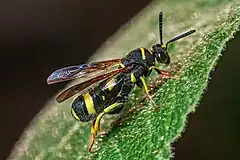| Leucospis dorsigera | |
|---|---|
 | |
| Leucospis dorsigera. Female during oviposition | |
| Scientific classification | |
| Domain: | Eukaryota |
| Kingdom: | Animalia |
| Phylum: | Arthropoda |
| Class: | Insecta |
| Order: | Hymenoptera |
| Family: | Leucospidae |
| Genus: | Leucospis |
| Species: | L. dorsigera |
| Binomial name | |
| Leucospis dorsigera Fabricius, 1775 | |
| Synonyms[1] | |
|
List
| |
Leucospis dorsigera is a species of wasp belonging to the family Leucospidae.
Distribution and habitat
This widely distributed species occurs from Eastern Russia through Europe (Austria, Croatia, Czech Republic, France, Germany, Hungary, Italy, Republic of Moldova, North Macedonia, Poland, Romania, Slovakia, Slovenia, Spain, Switzerland) to Near East and North Africa.[2][3] Leucospis dorsigera inhabits meadows and wet meadows and other areas where their hosts are abundant.[4]
Description
Leucospis dorsigera can reach a length of 10–12 millimetres (0.39–0.47 in).[4] This rather variable vespid-like specie mimics a stinging wasp. Body is quite robust, with yellow stripes on a black ground color. The fore wings are folded longitudinally. The hind femora are swollen and toothed along the lower margin, with a large median and short lateral teeth. The female shows a relatively short gaster and the ovipositor is turned up, lies along the dorsal side of the metasoma and just reaches to the base of the gaster. In the males the fusion of many of the metasomal segments to form a capsule-like "carapace".[2]

Biology
Adults can be found from May to July.[4] They mainly feed on nectar and pollen of Angelica sylvestris, Heracleum sphondylium and Scorzoneroides autumnalis.[4]
This species is an ectoparasitoid of aculeate wasps or bees. Females penetrate with the long ovipositor into the bark of trees where they have located the larvae of these insects. Then they lay the eggs in the body of these larvae, that will be eaten by the newly-born wasps.
Females especially parasitize larvae belonging to the family Megachilidae, genera Anthidiellum, Anthidium, Hoplitis and Osmia.[5] Larvae of Leucospis dorsigera also feed on larvae of Chelostoma florisomne and other larvae of Apidae (Megachilinae), Ichneumonidae (Xorides corcyrensis, Xoridinae) [4] and Bostrychidae (Coleoptera).[2]
Bibliography
- Klug, F. (1818) European species of |Leucospis|., JOURBOOK: Isis, Jena Vol.: 2(9) Pg: 1475
- Boucek, Z. (1974) A revision of the Leucospidae (Hymenoptera: Chalcidoidea) of the world., JOURBOOK: Bulletin of the British Museum (Natural History) Entomology Vol.: Supplement 23 Pg: 241pp
- Dalla Torre, K.W. von (1898) Catalogus Hymenopterorum hucusque descriptorum systematicus et synonymicus. V. Chalcididae et, Pg: 598pp
- Walker, F. (1862) Characters of undescribed species of the genus |Leucospis|., JOURBOOK: Journal of Entomology Vol.: 1 Pg: 16-23
- Westwood, J.O. (1834) On |Leucospis|, a genus of hymenopterous insects., JOURBOOK: Entomological Magazine VOLUME: 2(2) PAGES: 212-218
References
- ↑ Noyes, J.S. (2012) Universal Chalcidoidea Database
- 1 2 3 Shahram Hesami, Mohammad Ali Akrami, and Hannes Baur Leucospis dorsigera Fabricius (Hymenoptera, Leucospidae) as a Hyperparasitoid of Cerambycidae (Coleoptera) through Xoridinae (Hymenoptera: Ichneumonidae) in Iran
- ↑ "Leucospis dorsigera Fabricius, 1775". Fauna Europaea. Retrieved 2017-10-23.
- 1 2 3 4 5 J.K. Lindsey Ecology of Commanster
- ↑ Pietro Zandigiacomo, Filippo Michele Buian and Angela Bravin Reperti di Leucospis dorsigera (Fabricius) (Hymenoptera, Chalcidoidea, Leucospidae) nella Pianura veneta orientale
External links
 Data related to Leucospis dorsigera at Wikispecies
Data related to Leucospis dorsigera at Wikispecies Media related to Leucospis dorsigera at Wikimedia Commons
Media related to Leucospis dorsigera at Wikimedia Commons- Luciana Bartolini
- Biolib
- Bembix